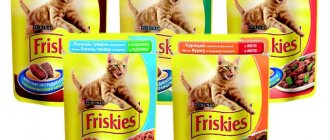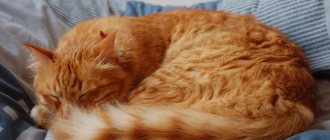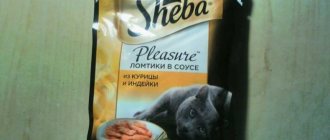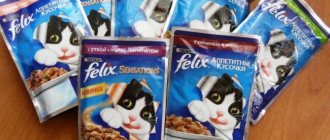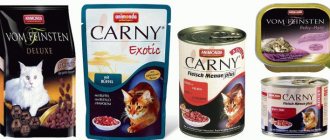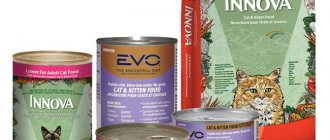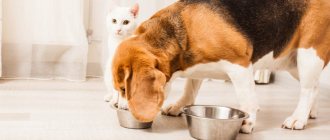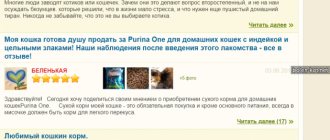Cat food can and should be tasty and healthy, but the owner will have to choose it. What should you pay attention to? What is cat food made from? Let's try to understand the issue and at the same time determine which manufacturer offers the most optimal version of the cat menu.
A pet is a full-fledged member of the family who has the right to its own cozy place and a balanced diet. Choosing a menu for him can be a problem. You need to please your taste without losing its benefits.
History of appearance
Prepared animal feed began to be produced in the 1860s. English electrician James Spratt invented the “dog biscuit”, which included beef blood, wheat and vegetables. These were the first crackers for pets; soon many businessmen picked up the idea and began producing similar products. In the 1890s, know-how migrated to the USA.
At the beginning of the 20th century, prepared pet foods became popular; the first canned food for cats was released in the 30s by Gaines Food.
In the 1940s, dry food also appeared. Since the metal was used to meet the needs of the front, canned food for animals was not produced. But the producers did not want to give up their profitable business, and therefore switched to dry products.
At that time, there were two types: granules (sold ready-made) and balls (they had to be kneaded by hand).
After the war, people's well-being improved, and they could already afford to purchase food for four-legged animals. Many companies have added this position to their product manufacturing. These were Mars, Lipton, Quaker Oats, Post, Carnation, etc. Most canned foods back then were fish.
A new milestone in the history of animal feed was the introduction of new technology in the 50s by Purina. This was using extrusion, a process of preparing feed by pushing it through an extruder. As a result of this treatment, the finished product seemed to be swollen, increased in volume, after which it was baked. Manufacturers used the new technology as a marketing ploy, offering more food for the same money, but the benefits of such products were questionable. Firstly, the crackers were sprinkled with flavorings, and secondly, a large amount of starch was added to the extrusion mixture - mostly corn.
Later, manufacturers contributed to an active educational campaign for pet owners, promoting the harmfulness of food from the owners’ tables for cats, thereby trying to increase sales of their products.
Is Kitekat harmful for cats: the opinion of veterinarians, animal owners, the manufacturer
Reviews about this food are contradictory. According to veterinarians, this product should not be in your pet’s diet. At the same time, they note that nothing bad will happen to a cat from using “Kitiket” once. However, constantly feeding your four-legged pet this food can result in serious problems with its health.
Buying economy-class ready-made cat products is similar to choosing food for people. If a person does not have the opportunity to buy quality meat, he buys inexpensive sausages or sausages. At the same time, he understands that they contain many chemical components and are unlikely to benefit his body. The same goes for cat food. Each cat owner buys food for it based on their financial capabilities.
If it is not possible to purchase high-quality food for your four-legged pet, veterinarians recommend following the following rules when feeding your pet cheap food:
- do not mix natural and prepared food;
- feed the animal with products of different forms of release of only one brand;
- When feeding your cat dry food, make sure that he drinks a lot of water;
- do not use vitamins without the consent of your veterinarian;
- follow the manufacturer's recommendations regarding the amount of feed and frequency of feeding;
- Feed pregnant and lactating pets more often, avoiding starvation.
Cat owners are divided into 2 camps regarding the harm of this food to the health of their pets. Opponents of cheap ready-made cat food consider it real poison. Its supporters are confident that if economy-class food is permitted by law and has certificates, it means that it has been tested for all safety and quality parameters and is not capable of causing harm. They believe that the main source of animal health problems is not the available food, but the owners of these pets themselves, who do not comply with the rules for using economy-class products.
, which is quite natural, does not consider its product harmful. He claims that his product is an ideal source of vitality for cats, as it contains all the necessary nutritional supplements and vitamins.
If you believe the advertising, “Kitekat” helps maintain muscle tone, strength and activity of the animal, strengthens its bones and teeth, gives the skin a healthy look and coat a magnificent shine, helps improve vision and stable heart function, strengthens the immune system and improves metabolic processes in the body .
In our time
Over the course of a century and a half, industrial animal feed has undergone significant changes, but not all owners are inclined to trust ready-made diets, doubting the quality of the original products. Therefore, owners continue to feed cats “human” food. Is this acceptable? And what is better for four-legged pets - ready-made food or natural products? This issue needs to be carefully looked into so as not to risk the health of our little brothers. To understand whether prepared foods are healthy, you need to understand what they are actually made from.
When choosing a product to feed your pet, it is important to analyze the composition of the first one by carefully reading the labels on the packaging. What is dry cat food made from?
What is a cat's natural diet?
Affectionate domestic cats are predators by nature. Borscht and cucumbers are not suitable for them as food. The digestive system of tailed pets practically does not digest such food.
In order for a cat to please its owners with health and a playful disposition, it needs to receive high-quality protein every day. Meat, fish, and offal should form the basis of the diet of any normal cat. In addition, sources of vitamins are also important for them. And these are vegetables, grains and vegetable oils.
All this is quite difficult to give to your pet in a day. When feeding regular food, you will have to cook not only for your family, but also for your cat.
Meat
The main ingredients in the composition are components of animal origin. These include not only meat itself, but also offal, fish and eggs. It is a source of protein for four-legged animals. The cat's body best absorbs amino acids from poultry, as well as fish, lamb and beef. This does not mean that the animal should not be given other types of meat food. If there are no allergies and the food is well digested, it is worth diversifying the menu by offering different types of crackers.
On the food package this ingredient may be written under the word “Meat”. This also includes animal muscle tissue, which may include fat, tendons, blood vessels, and skin. The “meat” is subjected to mechanical deboning, grinding into minced meat. The poultry and fish in the composition are usually isolated; they cannot be called “meat”. What else goes into ready-made animal food?
Animal Protein Level
Wild cats feed exclusively on small animals and practically do not eat plant foods. Their domestic counterparts differ from them only in size and appearance, but have retained all the anatomical and physiological features inherent in predators:
- sharp fangs;
- lower jaw, adapted only to vertical movements;
- a simple and short digestive tract with an acidic environment, optimal for the digestion of proteins;
- lack of amylase in saliva, a digestive enzyme that promotes the breakdown of carbohydrates.
Therefore, the most important ingredient in cat food is meat or fish. Without them, the predator’s body simply cannot function fully. But you should not rely on the total percentage of crude protein found in the guaranteed analysis. This indicator, like other basic nutrients, is regulated by industry standards and cannot be below a certain level.
In order to save money, some manufacturers add mainly grains and just a little meat to the food. In this case, the protein is brought to normal levels by vegetable protein, which is not able to provide the predator with all the necessary amino acids. The performance of such food will only please you. But it will not bring any benefit to the cat, because nature predetermines it a completely different type of nutrition.
When analyzing the composition of dry food, look at the main ingredients: at least the first five components (its basis) must be meat and fish. Eggs are also an excellent source of animal protein.
It is advisable that the packaging indicate what the mass fraction of a particular component is. For example: raw turkey meat (20%), chicken liver (10%), etc. By adding up the indicators of all sources of animal protein, we find out how suitable a given diet is for predators. For example, Acana and Orijen foods contain 75 and 85% meat components, respectively, which ideally meets the needs of cats.
Instead of meat
What else is included in cat food?
- Meat by-products. These are the remaining edible parts of mammals, for example, liver, kidneys, tripe. There may also be lungs and udders, although they are not edible for humans, animals can eat them.
- Bird. This refers to all edible parts of birds, except feathers, entrails, heads and legs. This also includes bones and skin. They are ground together with the pulp, and the bones are also a valuable source of calcium. The manufacturer often indicates the type of poultry - chicken, turkey.
- Poultry by-products. This includes heads, legs and intestines, as well as the heart, liver and stomach.
What is cat food made from? Inexpensive products called “Meat” and “Poultry” use by-products at best.
Rules for soaking dehydrated food for cats and kittens
The technology for soaking dry cat food granules is extremely simple and consists of the following steps:
- The required number of croquettes (dosages are indicated on the package) are poured into a metal or ceramic bowl. It is better not to use plastic dishes, because when hot food gets into it, harmful substances can be released.
- The bowl is filled with water heated to 50–60 °C, so that it completely covers the poured granules. You cannot use too hot a liquid, much less boiling water, because this destroys vitamins and many useful substances, and also denatures protein components. At the same time, the food loses its usefulness and nutritional value. Dry pieces filled with cold water will swell for too long. Take bottled, filtered or boiled water.
- Then the vessel is covered with a lid or saucer.
- After 15–20 minutes, the prepared, still slightly warm mixture can be given to the cat. But it’s better to mix the food first. For small kittens, swollen lumps should be thoroughly mashed with a fork or crushed in a blender.
Although many cat owners practice soaking freeze-dried food in warm milk (especially for kittens), this should not be done. Milk is quite fatty and in itself is a complete food product containing a number of vitamins and nutrients. Consuming it together with ready-made food can lead to digestive upset. In addition, active substances (simple sugars and amino acids) are capable of entering into chemical reactions with each other, which significantly violates the nutritional value of both components.
For small kittens, dry food can be soaked in cat milk replacer if they do not eat kibble soaked in water.
Flour
Flour or hydrolyzed product. What is found under this name in animal feed? During the processing process, moisture, fat, bacteria, and microorganisms are removed from the components under the influence of high temperature and pressure. Only proteins and minerals remain, they are ground to powder. The resulting powder is called “flour” or “hydrolyzed” product.
- Meat meal is a powder obtained from the processing of mammalian tissue, and not only muscle tissue. Thus, meat flour can be produced not only from meat, but also from offal. Mammals may be different; the manufacturer may indicate their species, but this is not necessary.
- Meat and bone meal. Almost the same as meat meal, but it also contains crushed bones. The manufacturer indicates the amount of minerals and nutrients, but does not have to indicate from whom the flour was obtained.
- Flour from animal by-products. It is obtained from meat, bones and offal. The starting raw material can be whole mammal carcasses.
- Poultry by-product meal. This component is obtained from whole poultry carcasses or their by-products. The raw materials are crushed and processed to remove moisture and fat. The result is a protein-mineral ingredient.
- Poultry meal. It is obtained by processing an ingredient called "Poultry". What is cat food made from and what else is present in its composition?
"Tricks" of manufacturers
In order to reduce the cost of the product, many people make cat food not based on animal proteins, but on their harmful substitutes - plant analogues. For this they use soybeans and corn. They are considered harmful to animals because they are very poorly digestible. In addition, cats are designed in such a way that:
- 40-50% of energy comes from proteins;
- 25-35% of the energy reserve is formed from fats;
- 20-30% energy from carbohydrates.
The most important danger is the starch present in corn. A component with a high glycemic index increases the risk of diabetes and also provokes the development of obesity in cats.
The nicotinic acid present in corn, niacin, also causes no less harm. It is not digestible by predatory animals. If the situation is not so critical with dogs, since niacin is partially synthesized from tryptophan, then cats need to restore the balance by introducing meat products into the diet.
Everything would be fine if manufacturers used pure grains in the manufacture of cat food. But pursuing the same goal of reducing costs, they often even use cake and cobs that are affected by the aflatoxin fungus.
Food often causes allergies in cats and dogs. An allergic reaction, as a rule, does not appear immediately, but some time after changing the food. Outwardly, this may look like areas of baldness on the face and paws, redness and scratching.
Vitamins and minerals
The processed raw materials from which cat food is produced are a source of proteins and carbohydrates. Vitamins and minerals are not preserved after processing, so they are added artificially. The manufacturer describes them:
- by simple enumeration - copper, iron, sodium, zinc, calcium;
- indicating specific substances containing minerals.
The sources of minerals are synthetic additives: iron amino acid complex, zinc polysaccharide complex. It is believed that minerals are better absorbed from such compounds.
Vitamins are also added in the form of artificial substances: cholecalciferol (vitamin D from animal sources), ergocalciferol (vitamin D from plants), riboflavin (vitamin B2), vitamin A, vitamin E, thiamine mononitrate (source of vitamin B1), vitamin B6.
So, behind complex chemical names are hidden artificial analogues of natural components that disappeared from the feed during processing. Amino acids (DL-methionine, L-lysine, DL-tryptophan) are also replaced.
Preservatives
Of course, any feed contains substances that ensure long-term storage of the product. Possible preservatives include:
- ascorbic acid;
- benzoic acid,
- butylated hydroxyl anisole (BHA),
- butylated hydroxyl toluene (BHT),
- calcium ascorbate,
- lemon acid,
- ethoxyquin,
- potassium sorbate,
- sodium bisulfate,
- tocopherols.
It is the manufacturer's responsibility to indicate the preservative used.
How to distinguish quality food?
Meat should be first on the ingredient list. The preferred by-products are kidneys, heart, stomach, liver, and lungs. Tripe and chicken heads are acceptable in small quantities. Such components are included in super-premium and holistic food categories.
General names such as “Meat”, “Poultry”, “Offal” are not desirable. Under these names, various ingredients may be used, and of questionable quality. If the manufacturer avoids specifics, perhaps he wants to hide something from the consumer.
Extracts instead of the substances themselves in the feed are undesirable. For example, instead of meat, hydrolyzed animal proteins may be included. Often the share of meat ingredients can be no more than 4%, as happens in economy-class feeds. This is very little for predators, and therefore such products are not useful for pets.
Below is a comparison of cat food composition.
Table of comparative analysis of feed by class
Characteristics of industrial cat food are given in the table.
| Characteristic | Trademark | % meat content | Price 1 kg, rub. |
| Economy | |||
| They contain by-products from meat ingredients, and low-quality grains and soy from vegetable ingredients. Additives include many carcinogens and artificial flavors. The cheapest and most undesirable class of food for a cat’s diet. Lead to indigestion, allergies, and chronic diseases. Sold in all supermarkets and widely advertised. | Whiskas, Friskas, Kitekat, Darling, Felix, Cat Chow (Cat Chow), Purina Van (Purina One), Perfect Fit (often classified as premium, but it does not reach it) | From 4 to 6 | From 80 |
| Premium | |||
| Average quality ingredients used. Quite a high content of animal proteins. Well absorbed by the cat's body with the least amount of indigestible waste. The cost is 20-50 percent higher than economy class. Most often sold in pet stores. | 1st Choice, Happy Cat, Hills, Proplan, Royal Canin, Yams, Probalance | From 10 to 20 | From 250 |
| Super premium | |||
| They have a balanced composition, high nutritional value, and are completely absorbed by the cat’s body. Contains natural meat and high-quality cereals. They do not contain artificial additives, taste improvers or carcinogenic substances. Expensive. Sold only in pet stores. | Monge, Leonardo, Bozita, Nature's Protection | 50 or more | From 700 |
| Holistics | |||
| Protein - only fresh and dehydrated meat and fish. No plant materials. Carbohydrates - potatoes, rice, peas, lentils. No corn, wheat. Only natural preservatives (tocopherols). Fiber - vegetables, fruits, dried berries. Hypoallergenic product. Sold only in specialized pet stores. | Akana, Orijen, Go Natural! (Go Natural), Now, Golden Eagle Holistic Health (Golden Eagle Holistic), Pronature Holistic | 50 and above | From 1450 |
Royal Canin Adult British Shorthair
Belongs to the premium class. Royal Canin dry cat food contains plant protein isolate and dehydrated animal proteins (poultry), as well as hydrolyzed animal proteins and a natural flavor additive. In addition, rice, wheat and cereal flour act as carbohydrates. The fats used are animal oil, fish oil and soybean oil. The fiber used is vegetable. There is a mineral supplement, yeast, fructooligosaccharides.
Royal Canin cat food comes in a wide range of flavors and contains a large amount of vitamins and minerals. However, the price of the goods is not low.
Wet food
They can be considered an intermediate link between canned food and dry mixes.
The main difference is humidity and packaging. These are usually single-dose food packets that are soft morsels in a jelly or sauce. Their humidity is much higher than that of dry food, but lower than that of canned food and is no more than 35 percent.
If the cat does not finish the portion, it quickly dries out and becomes unusable. You can put half a sachet in a bowl, open it and store it in the refrigerator.
"Felix" (in bags)
What is this brand of cat food made from? This is economy food. It contains meat and its processed products (4% chicken, 4% lamb). However, what kind of meat is included and how much of it is unknown. In addition, there is a vegetable protein extract, fish and its products, minerals, dyes, sugars, and vitamins. The advantages are considered to be affordable price and widespread availability. The disadvantages are that Felix cat food contains unknown components in unclear quantities.
What and how are they made from?
For the production of wet food for cats, mainly by-products are used: liver, kidneys, lungs. But meat is also necessarily present in the composition of not the cheapest feeds. Cheaper options add soy to replace expensive meat ingredients.
In order to know the composition for sure, you should first read it on the packaging. However, many manufacturers hide the real facts of the presence of certain ingredients in cat food.
Many wet foods are believed to have an addictive psychoactive substance added to them. Whether this information is true or just a “duck” launched by competitors, no one knows for sure.
A huge advantage of wet food is that various vitamins and minerals are added to them. Lack of them in a cat's diet can cause illness. When eating natural food, it is almost impossible to choose a balanced diet so that it meets all the needs of the animal.
Wet food is made on an industrial scale. To do this, meat and soy mass are ground together in huge meat grinders. The minced meat is then passed through the holes to form sausages. They are cut into small pieces and then mixed with the sauce. After packaging, the food is sterilized and packaged.
"Whiskas"
Economy class product. What is Whiskas cat food made from? Its production uses chicken, fish meal, turkey, corn, rice, animal fat, vitamins and minerals, preservatives and flavorings.
Disadvantages of this brand of food:
- Whiskas cat food contains many ingredients of dubious quality, indicated by general formulations.
- A large number of plant components.
- It is unclear what flavorings and preservatives are contained.
- High percentage of potential allergens (corn, caramel).
Acana Grasslands for Cats
The food belongs to the holistic class. It contains lamb, lamb liver, lamb flour, salmon, eggs, lentils, herring flour, lamb and duck fat, apples, carrots, cranberries, pumpkin, peas, vitamins and minerals, dandelion, chamomile, mint.
The food is characterized by a high meat content, the presence of preventive additives, duck, fish and lamb fats.
So, having figured out what cat food is made from, we now understand that if you choose this option for feeding your cat, you should purchase high-quality products, since they contain components beneficial to the health of the animal.
Liquid feeding problems
How to wean your cat off wet food
Cats eat wet food with great pleasure, but there are times when it is necessary to switch the cat to natural food “from the table”.
How to get her to eat human food if she is already accustomed to ready-made canned food? Alas, magic doesn't work here. You will just have to stop giving your cat processed food and wait until she starts eating natural food. Usually after 3-4 days the cat gives up, starts eating, and over time gets used to it and gets a taste for it. The main thing is not to let yourself feel sorry for yourself at the right moment and not to give up the idea.
The cat stopped eating liquid food
What should you do if your cat stops eating the liquid food you offer? If, apart from this, no symptoms are observed (vomiting, diarrhea, fever: in these cases you should immediately contact a specialist), then most likely the problem is the taste of the food. This can happen if you start giving your cat a different food, or the manufacturers have changed the composition. You can solve the problem by simply changing your diet.
